 By Jim Feilders
By Jim Feilders
June 6, 2016
BURLINGTON, ON
City council fully understands the impact climate change is having on us. The storm in August of 2014 brought that point home in a very vivid and expensive manner. More than three hundred residents suffered significant property loss. The city, the Conservation authority and the Regional government realized there were serious gaps in the level of preparedness.
The climate is changing due in part to the amount of carbon dioxide that is being allowed into the environment. Much of the CO2 is the result of the fossil fuels we burn to run our car engines and heat our homes.
The city has a number of plans in place to begin to cut back on the amount of carbon dioxide that is released into the environment.
Their task is to take specific actions and educate the public.
Burlington Carbon Plans Confusing You?
We have three plans affecting us regarding greenhouse gas emissions. Understanding what they mean can be a little difficult.
Strategic Plan
Council endorsed the Strategic Plan for the next 25 years to 2040 with one of many goals being to be net carbon neutral. It’s a tough call but the right thing to do in my opinion. But what does it mean? The definition in the Strategic Plan is “Having a net-zero carbon footprint refers to achieving net zero carbon emissions by balancing a measured amount of carbon released with an equivalent amount not used, or buying enough carbon credits to make up the difference”.
Talking to City officials, I learned that no one knows exactly how this will be achieved at the moment. Work will be done in the future.
But whatever is done must comply with the triple bottom line philosophy of sustainability. This means any plan must look at environmental and social impacts as well as economic. People have to be on board with the financial and environmental implications.
Province of Ontario
Last year the Province of Ontario announced its targets for carbon reduction to 2050.
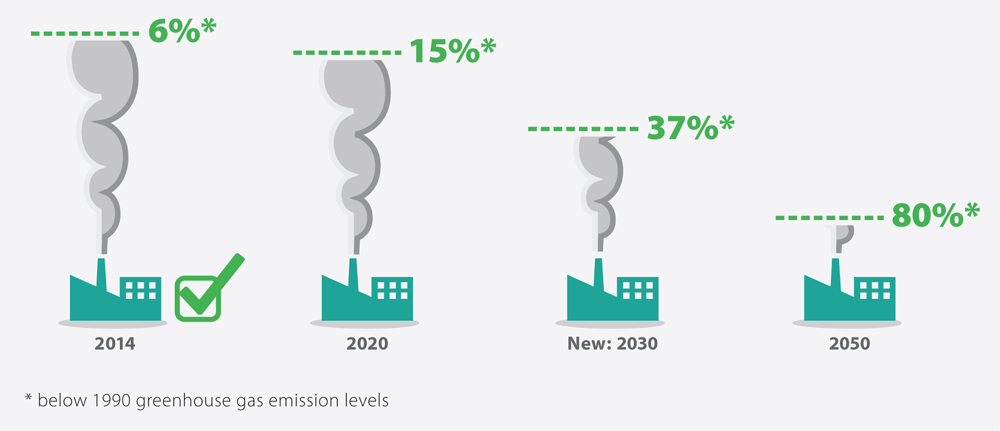
We know where we are and the targets for the future have been set – can we summon the discipline to achieve the targets?
Our Premier says we have to reduce total carbon by 37% in 2030 and 80% in 2050 – from 1990 levels.
Community Energy Plan
We have started to address this in the Community Energy Plan (CEP) that Council endorsed in January 2014; a lot of progress has been made.
The focus of the plan is to reduce energy consumption and cost as well as reduce greenhouse gases and improve local energy security.
The timeframe is to 2030. A report on progress to date is available here
It didn’t relate to 1990 levels. We didn’t track them back then and the closest we have is 1994 of 1.4 Mtonnes – close enough. This shows we met the 2014 target (1.4 – 1.19 = 0.21 or 15%, see below) and probably will meet the 2020 targets (1.4 – 1.1 = 0.3 or 21%). But we’re looking a little shy for 2030, coming in at 27%.
The CEP has set a realistic target of 26% reduction in energy consumption per person over the 15 year period from 2014 to 2030.
Although mention is made of investigating heat pump technologies and electric vehicles, the plan does not rely on switching fuels but reducing the amount we use as well as generating new energy from renewable sources. As a result, the amount of greenhouse gas reduction is the same as the energy reduction. If you drive less and save a 65 litre tank of gasoline and you save 156 kg of pollution. If you switch to an alternate fuel, you can still travel almost the original distance.
The plan does not account for population growth which is predicted to rise from 175,000 by about 30,000 people over this period depending on whether you look at the City’s estimates or the Province’s Places to Grow. This is about a 17% population increase. This tells me that if 175,000 people reduce their carbon by 26% and 30,000 people are added to the mix at the same reduction, the net decrease for the City is 14% to 1.025 Mtonnes from 1.19 Mtonnes.
Putting it all together with the best data I could find, is shown in the chart below. It includes the “What if” we do nothing, called business as usual. You know, keep our heads in the sand and keep doing what we have always done. I’m not saying change is easy by any means.
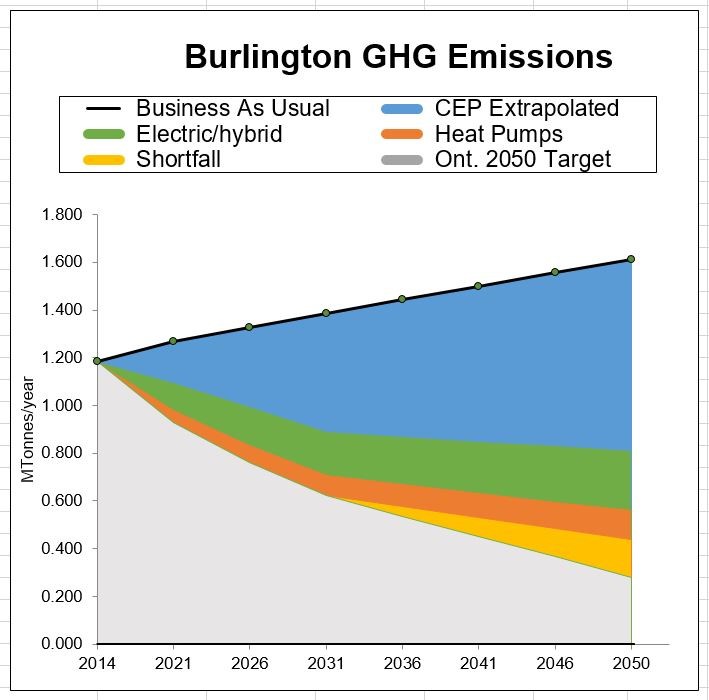
The obvious solution is to make the Community Energy Plan work – problem with that is we don’t know yet how to do that.
Extrapolations for the CEP are less optimistic as most of the behavioural change will have occurred. With our CEP alone, we fall short.
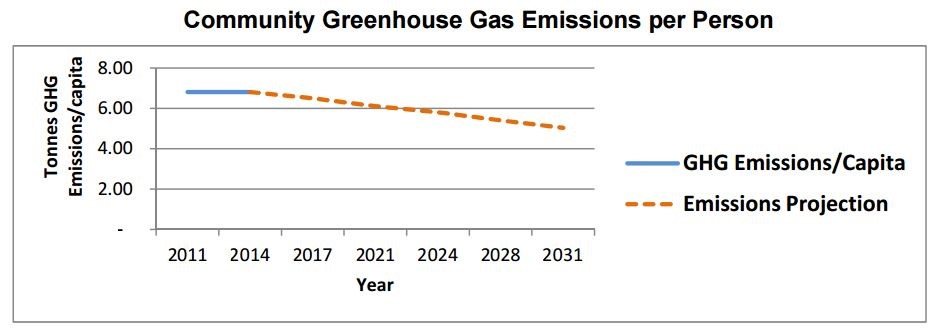
If we determine what the plan is and then stick to the plan – there is hope for us – but we have a long way to go – and it is not going to be easy.
Enter fuel switching. We need to replace gasoline vehicles with electric and hybrid models and transition our residential space heating and water heating from natural gas to electric inverter heat pump technology – air, water and ground sources.
These technologies are actually less expensive on a life cycle basis than their fossil fuel alternatives. Approaches that use a “hybrid” system of gas furnace and heat pump are available. So we can save the planet and money at the same time.
This will bring us close enough that industry can make up the remaining gap.
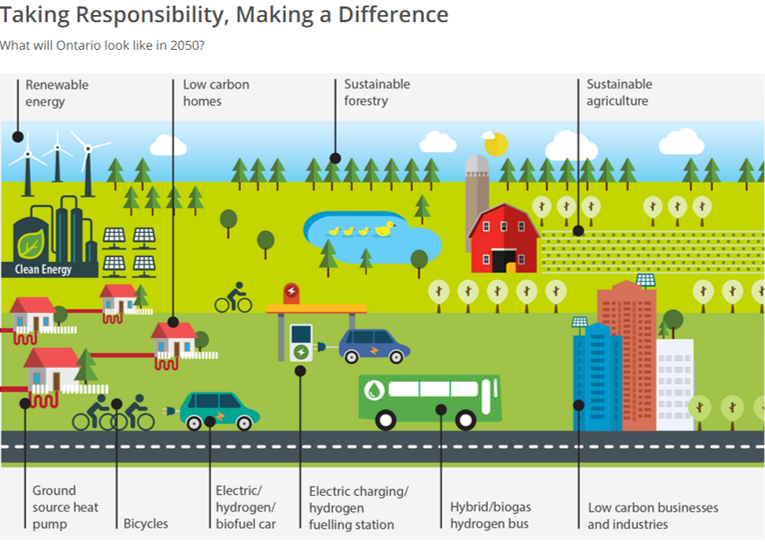 Halleluiah! We can do it and get our gold star from Kathleen living the life she depicts below.
Halleluiah! We can do it and get our gold star from Kathleen living the life she depicts below.
To now go for carbon neutral may not seem impossible.
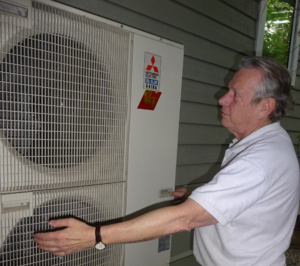 Jim Feilders is an engineer by training and an environmentalist by choice. He drives a hybrid car, heat and air conditions his house at a cost of of approximately $375 a year. The views expressed here are solely his own and not necessarily those of the various organizations with which he is associated.
Jim Feilders is an engineer by training and an environmentalist by choice. He drives a hybrid car, heat and air conditions his house at a cost of of approximately $375 a year. The views expressed here are solely his own and not necessarily those of the various organizations with which he is associated.















Great article Jim. You sum up the greenhouse gas reduction plans for both the City and the Province very nicely. Human kind has not yet fully faced the real cost of our profligate lifestyle resulting in species extinction at an alarming rate, in addition to threatening our very existence on planet Earth. Hopefully the soon to be introduced Cap and Trade plans by the Province will encourage more earth friendly ways of living.
We have had a ground source heating and cooling system in our rural home since late 2006. The decision to convert from base board electrical to ground source has been one of the best we have ever made. In addition to substantial reductions on our heating bill we now have a very efficient cooling system (not possible with electrical base boards). The other factor to consider is that the real estate value of our home increased by at least the cost of the ground source system (comparing a base board heated versus a ground source heated home). In the 9.5 years years since installation we have had one service call under the warranty in the first year and not a single service call since.
Stay tuned for the article on heat pumps. In rural areas with no natural gas, air source and ground source heat pumps have very short paybacks over electric baseboard, propane and oil. But this article is about carbon emissions which are up to 90% less than fossil fuel alternatives. Come have a tour of my house in downtown Burlington and see my air source heat pump in action. Jim Feilders
Don’t get me wrong, though. It is my hope that we can use hydrogen as a main energy source, or the, always 25 years away, nuclear fusion. Practical hydrogen harvesting may closer then we think. It is my hope.
“Latest bionic leaf now 10 times more efficient than natural photosynthesis”
https://www.gizmag.com/bionic-leaf-2-more-efficient-photosynthesis/43691/
From Canada’s Green Building Council
“A geothermal system for an averaged size home (2000 sq. ft.) would cost you approximately $25,000 to install, in exchange for a monthly saving of about 50% on your heating bill. So payback for the average single family home is simply too far away to make this a financially competitive option with all but the most enormous and poorly performing houses.”
https://www.ecohome.net/guide/geothermal-heating-cooling
How effective are underground heat pumps this far north??? Their installation costs are very expensive. Who pays for that? Hydrogen is the most abundant element but extracting it from the air is very expensive and hopelessly inefficient at this time. Unless new technology that doesn’t produce C02 while extracting it is invented, it’s just another pie in the sky dream.
Editors note:
The developer of the Ironstone project on Appleby Line would beg to differ. They installed geothermal to their building and it is working just fine. Do better homework before you comment.
https://www.burlingtongazette.ca/geothermal-ironstone/
Suicide for Ontario.